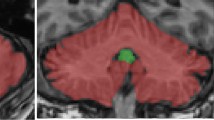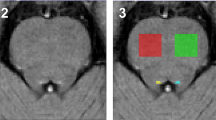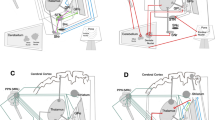Abstract
Niemann–Pick disease type C (NPC) is a rare neurovisceral disorder resulting in impaired intracellular lipid trafficking. The only disease-modifying treatment available to date is miglustat, an iminosugar inhibiting the accumulation of lipid by-products in neurons. This study explored how changes in cerebellar grey and white matter volumes, and in subcortical volumes, related to patient treatment status and disability and ataxia ratings. Nine adult-onset NPC patients and 17 matched controls underwent T1-weighted MRI. One patient was not receiving miglustat, and pre-treatment data were available for a further patient. Semi-automated cerebellar and subcortical segmentation was undertaken, and the rates of change in putamen, hippocampal, thalamic and caudal volumes, and grey and white matter cerebellar volumes, were compared to rates of change in Iturriaga disability score, Brief Ataxia Rating Scale (BARS), and horizontal saccadic gain. Untreated NPC patients appeared to lose cerebellar grey and white matter, bilateral thalamic volume, and right caudate volume faster than treated patients. Cerebellar grey matter volume loss and volume loss in the left thalamus were significantly correlated with Iturriaga disability scale changes. Change in both cerebellar grey and white matter was correlated with decrease in horizontal saccadic gain, but not with change in BARS. This is the first study to examine longitudinal treatment effects of miglustat on cerebellar and subcortical volumes in patients with adult-onset NPC, and is evidence that miglustat may have a protective effect on cerebellar and subcortical structure and function.


Similar content being viewed by others
References
Walterfang M, Fietz M, Fahey M, Sullivan D, Leane P, Lubman DI, Velakoulis D (2006) The neuropsychiatry of Niemann–Pick type C disease in adulthood. J Neuropsychiatry Clin Neurosci 18(2):158–170. doi:10.1176/appi.neuropsych.18.2.158
Sevin M, Lesca G, Baumann N, Millat G, Lyon-Caen O, Vanier MT, Sedel F (2007) The adult form of Niemann–Pick disease type C. Brain 130(Pt 1):120–133. doi:10.1093/brain/awl260
Zervas M, Dobrenis K, Walkley SU (2001) Neurons in Niemann–Pick disease type C accumulate gangliosides as well as unesterified cholesterol and undergo dendritic and axonal alterations. J Neuropathol Exp Neurol 60(1):49–64
Suzuki K, Parker CC, Pentchev PG, Katz D, Ghetti B, D’Agostino AN, Carstea ED (1995) Neurofibrillary tangles in Niemann–Pick disease type C. Acta Neuropathol 89(3):227–238
Taniguchi M, Shinoda Y, Ninomiya H, Vanier MT, Ohno K (2001) Sites and temporal changes of gangliosides GM1/GM2 storage in the Niemann–Pick disease type C mouse brain. Brain Dev 23(6):414–421
Walterfang M, Abel LA, Desmond P, Fahey MC, Bowman EA, Velakoulis D (2013) Cerebellar volume correlates with saccadic gain and ataxia in adult Niemann–Pick type C. Mol Genet Metab 108(1):85–89. doi:10.1016/j.ymgme.2012.11.009
Walterfang M, Fahey M, Desmond P, Wood A, Seal ML, Steward C, Adamson C, Kokkinos C, Fietz M, Velakoulis D (2010) White and gray matter alterations in adults with Niemann–Pick disease type C: a cross-sectional study. Neurology 75(1):49–56. doi:10.1212/WNL.0b013e3181e6210e
Patterson MC, Vecchio D, Prady H, Abel L, Wraith JE (2007) Miglustat for treatment of Niemann–Pick C disease: a randomised controlled study. Lancet Neurol 6(9):765–772. doi:10.1016/S1474-4422(07)70194-1
Stein VM, Crooks A, Ding W, Prociuk M, O’Donnell P, Bryan C, Sikora T, Dingemanse J, Vanier MT, Walkley SU, Vite CH (2012) Miglustat improves purkinje cell survival and alters microglial phenotype in feline Niemann–Pick disease type C. J Neuropathol Exp Neurol 71(5):434–448. doi:10.1097/NEN.0b013e31825414a6
Zervas M, Somers KL, Thrall MA, Walkley SU (2001) Critical role for glycosphingolipids in Niemann–Pick disease type C. Curr Biol 11(16):1283–1287
Iturriaga C, Pineda M, Fernandez-Valero EM, Vanier MT, Coll MJ (2006) Niemann–Pick C disease in Spain: clinical spectrum and development of a disability scale. J Neurol Sci 249(1):1–6. doi:10.1016/j.jns.2006.05.054
Schmahmann JD, Gardner R, MacMore J, Vangel MG (2009) Development of a brief ataxia rating scale (BARS) based on a modified form of the ICARS. Mov Disord 24(12):1820–1828. doi:10.1002/mds.22681
Abel LA, Walterfang M, Fietz M, Bowman EA, Velakoulis D (2009) Saccades in adult Niemann–Pick disease type C reflect frontal, brainstem, and biochemical deficits. Neurology 72(12):1083–1086. doi:10.1212/01.wnl.0000345040.01917.9d
Abel LA, Bowman EA, Velakoulis D, Fahey MC, Desmond P, Macfarlane MD, Looi JC, Adamson CL, Walterfang M (2012) Saccadic eye movement characteristics in adult Niemann–Pick Type C disease: relationships with disease severity and brain structural measures. PLoS One 7(11):e50947. doi:10.1371/journal.pone.0050947
Reuter M, Schmansky NJ, Rosas HD, Fischl B (2012) Within-subject template estimation for unbiased longitudinal image analysis. Neuroimage. doi:10.1016/j.neuroimage.2012.02.084
Reuter M, Fischl B (2011) Avoiding asymmetry-induced bias in longitudinal image processing. Neuroimage 57(1):19–21. doi:10.1016/j.neuroimage.2011.02.076
Free SL, Bergin PS, Fish DR, Cook MJ, Shorvon SD, Stevens JM (1995) Methods for normalization of hippocampal volumes measured with MR. AJNR Am J Neuroradiol 16(4):637–643
Jack CR Jr, Twomey CK, Zinsmeister AR, Sharbrough FW, Petersen RC, Cascino GD (1989) Anterior temporal lobes and hippocampal formations: normative volumetric measurements from MR images in young adults. Radiology 172(2):549–554. doi:10.1148/radiology.172.2.2748838
Platt FM, Neises GR, Dwek RA, Butters TD (1994) N-butyldeoxynojirimycin is a novel inhibitor of glycolipid biosynthesis. J Biol Chem 269(11):8362–8365
Walterfang M, Fahey M, Abel L, Fietz M, Wood A, Bowman E, Reutens D, Velakoulis D (2011) Size and shape of the corpus callosum in adult Niemann–Pick type C reflects state and trait illness variables. AJNR Am J Neuroradiol 32(7):1340–1346. doi:10.3174/ajnr.A2490
Walterfang M, Patenaude B, Abel LA, Kluenemann H, Bowman EA, Fahey MC, Desmond P, Kelso W, Velakoulis D (2012) Subcortical volumetric reductions in adult Niemann–Pick Disease type C: a cross-sectional study. AJNR Am J Neuroradiol. doi:10.3174/ajnr.A3356
Walterfang M, Macfarlane MD, Looi JC, Abel L, Bowman E, Fahey MC, Desmond P, Velakoulis D (2012) Pontine-to-midbrain ratio indexes ocular-motor function and illness stage in adult Niemann–Pick disease type C. Eur J Neurol 19(3):462–467. doi:10.1111/j.1468-1331.2011.03545.x
Zaaraoui W, Crespy L, Rico A, Faivre A, Soulier E, Confort-Gouny S, Cozzone PJ, Pelletier J, Ranjeva JP, Kaphan E, Audoin B (2011) In vivo quantification of brain injury in adult Niemann–Pick Disease type C. Mol Genet Metab 103(2):138–141. doi:10.1016/j.ymgme.2011.02.013
Galanaud D, Tourbah A, Lehericy S, Leveque N, Heron B, Billette de Villemeur T, Guffon N, Feillet F, Baumann N, Vanier MT, Sedel F (2009) 24 month-treatment with miglustat of three patients with Niemann–Pick disease type C: follow up using brain spectroscopy. Mol Genet Metab 96(2):55–58. doi:10.1016/j.ymgme.2008.10.002
Vite CH, Ding W, Bryan C, O’Donnell P, Cullen K, Aleman D, Haskins ME, Van Winkle T (2008) Clinical, electrophysiological, and serum biochemical measures of progressive neurological and hepatic dysfunction in feline Niemann–Pick type C disease. Pediatr Res 64(5):544–549. doi:10.1203/PDR.0b013e318184d2ce
Solomon D, Winkelman AC, Zee DS, Gray L, Buttner-Ennever J (2005) Niemann–Pick type C disease in two affected sisters: ocular motor recordings and brain-stem neuropathology. Ann N Y Acad Sci 1039:436–445. doi:10.1196/annals.1325.041
Rottach KG, von Maydell RD, Das VE, Zivotofsky AZ, Discenna AO, Gordon JL, Landis DM, Leigh RJ (1997) Evidence for independent feedback control of horizontal and vertical saccades from Niemann–Pick type C disease. Vision Res 37(24):3627–3638. doi:10.1016/S0042-6989(96)00066-1
Takagi M, Zee DS, Tamargo RJ (1998) Effects of lesions of the oculomotor vermis on eye movements in primate: saccades. J Neurophysiol 80(4):1911–1931
Elleder M, Jirasek A (1981) Neuropathology of various types of Niemann–Pick disease. Acta Neuropathol Suppl 7:201–203
German DC, Quintero EM, Liang CL, Ng B, Punia S, Xie C, Dietschy JM (2001) Selective neurodegeneration, without neurofibrillary tangles, in a mouse model of Niemann–Pick C disease. J Comp Neurol 433(3):415–425
Fusco C, Russo A, Galla D, Hladnik U, Frattini D, Giustina ED (2013) New Niemann–Pick type C1 gene mutation associated with very severe disease course and marked early cerebellar vermis atrophy. J Child Neurol 28(12):1694–1697. doi:10.1177/0883073812462765
Lopez ME, Klein AD, Dimbil UJ, Scott MP (2011) Anatomically defined neuron-based rescue of neurodegenerative Niemann–Pick type C disorder. J Neurosci 31(12):4367–4378. doi:10.1523/JNEUROSCI.5981-10.2011
Acknowledgments
The authors would like to acknowledge the support of the patients and their families in providing clinical information for this study.
Author information
Authors and Affiliations
Corresponding author
Ethics declarations
Conflicts of interest
Elizabeth Bowman has received salary support through an unrestricted educational grant to The University of Melbourne from Actelion Pharmaceuticals Limited. Dennis Velakoulis has received royalties from the publication of Kaplan and Sadock’s Comprehensive Textbook of Psychiatry (Lippincott Williams & Wilkins, 2009) and research support from the NHMRC. Larry Abel has served as a consultant on previous clinical trials and currently as a consultant for and received funding for travel from Actelion. Patricia Desmond serves on the editorial board of the Journal of Clinical Neuroscience and as an Associate Editor of the Journal of Medical Imaging and Radiation Oncology and receives research support from NHMRC, Cancer Australia, the National Health Foundation, and The Royal Melbourne Hospital Neuroscience Foundation. Michael Fahey has served on a scientific advisory board and as a consultant for and received funding for travel from Actelion Pharmaceuticals Ltd.; has received speaker honoraria from the Australian Podiatry Association; receives research support from NHMRC and the NIH (1R03HD058625-01, CI); has held/holds stock in Sigma Pharmaceuticals, LLC, and Peplin, Inc.; and has given expert testimony on behalf of the Therapeutic Goods Administration. Mark Walterfang has served on a scientific advisory board and as a consultant for and received funding for travel from Actelion Pharmaceuticals Ltd. and received royalties from the publication of Kaplan and Sadock’s Comprehensive Textbook of Psychiatry (Lippincott Williams & Wilkins, 2009).
Ethical standard
This study was approved by the Melbourne Health Research & Ethics Committee and has therefore been performed in accordance with the ethical standards laid down in the 1964 Declaration of Helsinki. All patients gave their informed consent to participate in this study.
Informed consent
This study was approved by the Melbourne Health Human Research Ethics Comittee (approval codes HREC2004.042 and HREC2005.168). All procedures followed were in accordance with the ethical standards of the responsible committee on human experimentation (institutional and national) and with the Helsinki Declaration on human experimentation of 1975, as revised in 2000(5). Informed consent was obtained from all patients for being included in the study.
Additional information
E. A. Bowman and M. Walterfang have contributed equally to this work and are equal first authors.
Rights and permissions
About this article
Cite this article
Bowman, E.A., Walterfang, M., Abel, L. et al. Longitudinal changes in cerebellar and subcortical volumes in adult-onset Niemann–Pick disease type C patients treated with miglustat. J Neurol 262, 2106–2114 (2015). https://doi.org/10.1007/s00415-015-7819-z
Received:
Revised:
Accepted:
Published:
Issue Date:
DOI: https://doi.org/10.1007/s00415-015-7819-z




